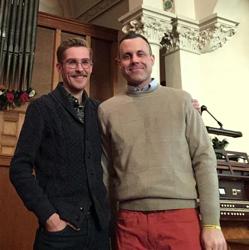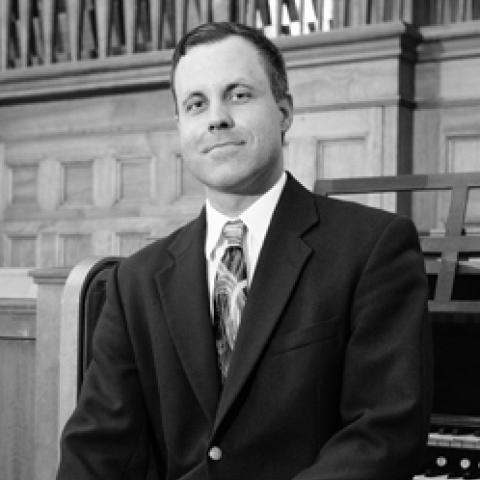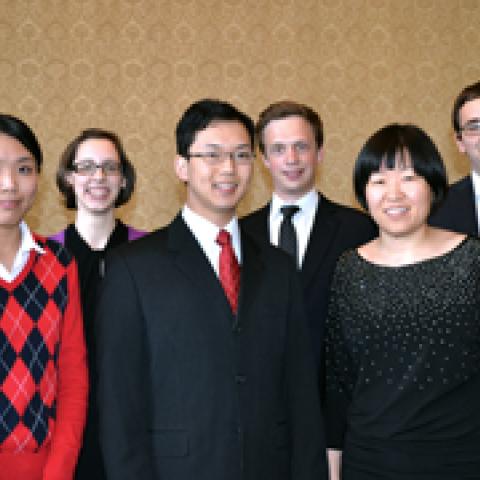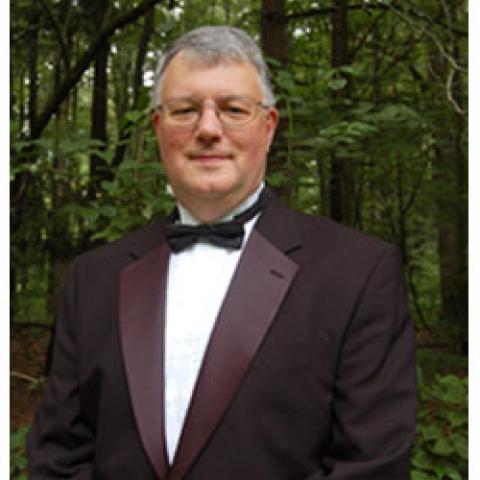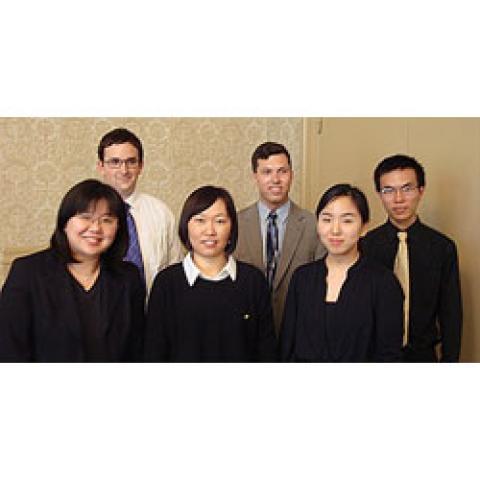It was a frustrating two years of hopeful submissions and
disappointing rejections. Imagine--you are a performer and enthusiast of
new music and you have just been given the greatest gift: a piece of music
written and dedicated to you! You so emphatically believe this composition
should be shared with the world that you do everything you can to find the
piece a publisher, only to be told that it is “a wonderful piece that
won’t sell” or “beautifully written, but the sales it would generate
in today’s market wouldn’t offset the cost of printing it.”
In the spring of 1999, Jim (Biery) and I were given the gift
of an organ duet by one of our composer friends, David Evan Thomas of St. Paul.
Written in the Dust is a symphony for organ duet, written by a versatile composer
whose works have been performed by the Minnesota Orchestra and the Minnesota
Opera, who is Composer-in-Residence at the Schubert Club in St. Paul, and whose
undergraduate years of study at Northwestern University included organ lessons
with Robert Delcamp, currently University Organist at University of the South
in Sewanee, Tennessee. Written in the Dust is
a semi-programmatic work based on the scripture story from John 8: 3-11
about the woman who is caught in adultery, whose punishment was to be stoned
for her sin. Jim and I are convinced that Thomas’ duet is one of the
finest examples of literature written for the genre. We were so excited about Written
in the Dust that after the premiere, I
started sending it off to various publishers for consideration. I tried
publishers in the United States, England and France. All were very impressed
with the work; none agreed to publish it.
In the fall of 2001, I broached my frustration to Mark
Lawson, President of MorningStar Music Publishers. MorningStar was founded in
1987 by Rodney Schrank; in 1997 Mark Lawson became president and has continued
the MorningStar tradition of publishing quality music with particular emphasis
on choral, organ and handbell music. Not only did Lawson agree to publish it,
he suggested that we start a series of music that would fit into this category:
Concert Organ Series at MorningStar. The series would include pieces that were
not composed for worship (although some portions or movements could be used as
such), that would be primarily non-chorale based, more virtuosic, more
extended, and more developed than the music currently published by the houses
which promote (primarily sacred) organ music in the United States today. Lawson
says: “I would like this series to encourage composers to continue to
create concert works, and MorningStar will endeavor to make them available to
those interested in obtaining them.”
The reason that Lawson could suggest such a project without
as much concern for its potential to return the publisher’s investment is
that his investment is minimal. Technology today has made it practical for
composers to print their own publisher-ready scores using a computer program,
and therefore submit camera-ready copy. Some publishers use this system often,
others still have their own engraver convert the computer file so that it
matches their other printed scores. In the case of MorningStar, Lawson decided
to ask each Concert Organ Series composer to submit their score camera-ready,
and then MorningStar would print the copies as needed instead of committing to
a set number of printed copies.
What Lawson has done with the formation of this series is to
make a commitment to supporting composers who are writing for the organ as a
concert instrument, by advertising and making their works available through his
catalog of music for the church. Since the beginnings of the idea in 2001, the
catalog has grown to include music by Herb Bielawa, James Biery, Emma Lou
Diemer, Charles Hoag, James Hopkins, Robert Sirota, David Evan Thomas, and
others.
Emma Lou Diemer, 1995 AGO Composer of the Year, has had
numerous collections of organ pieces published. In addition to her organ music, Diemer has written many
works for orchestra, chamber ensemble, solo voice, choir and electronic tape. She
has received an ASCAP award for publications and performances annually since
1962. Diemer says of the Concert Series: “This venture by MorningStar is
producing a treasury of new music that every concert organist will want to
delve into.”1
Herb Bielawa is a free-lance composer and pianist, married
to organist Sandra Soderlund. He has written music for instrumental ensembles,
piano, harpsichord, organ, choir, electronics, chamber opera, band and
orchestra. Bielawa recently remarked on the MorningStar series:
“MorningStar’s new series is certainly a beacon in a very dark sky.
Their bravery in embarking on this kind of project to support serious classical
music is truly laudable.”2
James Hopkins, Professor of Music Composition at the
University of Southern California, whose compositions have been performed by
the National Symphony, Denver Symphony, Los Angeles Philharmonic, Seattle
Symphony, Pacific Symphony, Fine Arts Quartet, the Western Arts Trio and the
Washington Choral Society, has received commissions from the National Endowment
for the Arts, Pasadena Chamber Orchestra and the American Guild of Organists.
Hopkins says: “I am very pleased that MorningStar provides an outlet for
music which, because of its technical demands, duration, or other elements will
necessarily not have a large commercial market. Nevertheless, this music, I
hope, merits serious attention by those whose abilities and performance venues
make these compositions entirely appropriate.”3
John Nuechterlein, President and Chief Executive Officer at
the American Composers Forum, based at the home office in St. Paul, is
supportive and enthusiastic about MorningStar’s new series: “Three
cheers to MorningStar for taking this giant leap forward. New work is critical
for the long-term health of the repertoire, and the Concert Organ Series will
offer a visible showcase for the best literature being written for organ
today.”4
Libby Larsen, American composer and tireless advocate for
contemporary music and musicians, says: “To challenge ourselves with the
compelling poetic voices of our time is really the only choice for serious
students and performers of the organ.”5
This new series deserves to thrive under the good will and
support of organists at all levels of experience and technical expertise. Organists
can support this project by collecting these scores either for performance or
for personal libraries of organ music. The list of pieces currently offered by
MorningStar on the Concert Series follows, with some description of each work.
MorningStar Concert Organ Series list of works
Organ Solo:
A Diet of Worms, Michael Horvit
Subtitled “An Entertainment for All Hallows Eve and
Other Cheery Occasions,” A Diet of Worms was written for the first annual
“Monster Concert” of the Houston Chapter of the American Guild of
Organists, held on Halloween night 1979. The title is a play on words, relating
to the two main themes employed in the work. The main body of the piece is a
passacaglia based on the children’s song “The worms crawl in, the
worms crawl out” (the tune from Paul Dukas’ The Sorcerer’s
Apprentice). The other important theme is the chant melody Dies Irae from the
pre-Vatican II Requiem Mass, which Hector Berlioz used as the “Witches
Sabbath” theme in his Symphonie fantastique. In the composer’s mind,
this made a connection to the medieval Church conclave, the Diet of Worms.
h2>Celestial Wind, Robert Sirota
In composing Celestial Wind, Sirota was inspired to write a
brilliant toccata based upon Acts 2:2-3:
And suddenly there came a sound from heaven of a rushing and
mighty wind, and it filled all the house where they were sitting.
And there appeared unto them cloven tongues like as of fire,
and it sat upon each of them.
Sirota’s aim was not merely to imitate the sound of
rushing wind and flames, but to also evoke the sense of awe and ecstasy that
must have been felt by Jesus’ disciples at this manifestation of the Holy
Spirit. (Example 1)
Cityscape, Morgan Simmons
Cityscape dates from 1992 and was composed for inclusion in
an organ recital of Chicago composers as part of the Fourth Presbyterian
Church’s annual Festival of the Arts. The theme of that year’s
festival was “Faces of the City.” This three-movement work, which
depicts facets of the city, is based on a three-note descending scale (C-B-A),
the opening notes of the popular song, “Chicago, Chicago, That
Toddlin’ Town.” Coincidentally, this same melodic sequence marks
the beginning of Old Hundredth, and a citation of that melody occurs in the
third movement. The Fourth Presbyterian Church is located on the part of North
Michigan Avenue which is known as “The Magnificent Mile.” Each of
its Sunday morning services begins with the singing of Old Hundredth, sung to
the text of the Doxology. The first performance of Cityscape was played by
David Schrader, to whom it is dedicated.
Overture to Coriolan, op. 62, Ludwig van Beethoven, arranged
for organ by James Biery
Beethoven composed nine symphonies, eleven overtures, a
violin concerto and five piano concertos, sixteen string quartets, nine piano
trios, ten violin sonatas and five cello sonatas, thirty large piano sonatas,
an oratorio, an opera, two Masses, and numerous smaller pieces, but only one
curious work for the pipe organ, an odd little Prelude which passes through all
the major keys. In 1824 Beethoven wrote to Freudenberg, an organist from
Breslau, “I, too, played the organ frequently in my youth, but my nerves
could not withstand the power of this gigantic instrument. I should place an
organist who is master of his instrument at the very head of all
virtuosi.”6 The opening unison C’s and exclamatory chords of the
Coriolan overture, each followed by some of the most resounding rests in all of
music literature, allow the magnificent King of Instruments to add its own
voice to Beethoven’s powerful music.
Deux Danses, James Hopkins
Hopkins’ Deux Danses for organ was composed in 1983
and was premiered by James Walker at the AGO Far-Western Regional convention in
June of that year. The titles for each of the dances were suggested by two
legends from Greek mythology. The title of the first dance, Mirror of Medusa,
refers to the tale of the Medusa. She was one of the three fearsome monsters
called Gorgons. Her body was covered with scales, her hair was a mass of
twisting snakes, and whoever looked at her turned into stone. In the legend,
Medusa was slain by the Greek hero Perseus, who used a shield of polished
bronze as a mirror with which to see her. The title of the second dance, The
Circle of Bacchants, refers to the followers of Bacchus, the God of Wine. The
Bacchants, being frenzied with wine, rushed through the wilderness
“uttering shrill cries and performing frightful deeds.” (Example 2)
Fantasy on Cortège et Litanie of Marcel Dupré,
James Hopkins
The Fantasy on Cortège et Litanie of Marcel
Dupré was composed in 1986 as a solo piece for concert organist Cherry
Rhodes and first performed by her in October, 1989, at Grace Cathedral, San
Francisco. Because of the very orchestral nature of the writing, the composer
decided in 1994 to recast the work in a second version for small orchestra. The
Fantasy is based on the two main themes of the well-known work Cortège
et Litanie of Dupré. Even though one or both of these themes is almost
always present in some form, there is in fact no direct quotation from the
original work. The harmonic style, while incorporating some fairly dissonant
combinations, nevertheless retains Dupré’s original E major tonal
framework. The first part of the Fantasy consists of several short sections
that evoke a vague, dream-like atmosphere. After a brief cadenza, the
rhythmically driving central portion of the work is heard. A short
recapitulation of earlier material and a final triumphant outburst bring the
Fantasy to a joyous conclusion. Hopkins’ Fantasy won first prize in an
international composition contest sponsored by the Los Angeles Chapter of the
AGO.
Five Pipe Organ Adventures, Herbert Bielawa
This set of relatively short organ pieces dates from 1993
and was written for specific groups of musicians: those who have recently
become interested in the pipe organ, those who have yet to discover it and
those who are intrigued by the pieces themselves. The Adventures were composed
with a capable keyboard player in mind, with minimal skill or experience
playing pedals. The pedal parts are fairly basic and undemanding. The number of
pedal notes in Adventures is limited, changing foot position occurs when manual
activity is minimal, and occasionally no pedal is required at all.
Four Biblical Settings, Emma Lou Diemer
This major work was commissioned by the Ventura, California
chapter of the AGO. The four movements feature a variety of styles, including
minimalism, rhythmic innovation, and subtle dissonances. It was premiered on
June 30, 1993 by Sandra Soderlund in Santa Barbara. The movements are based on
Psalm 90, Psalm 121, Isaiah 11:1 and Isaiah 35:1. The first movement is in a
minimalist style and is innovative in the way that the increments in
“volume” of the crescendo pedal are used not only for drama but to
define the phrase structure of the movement and to express the imagery in Psalm
90. The second movement (Psalm 121) has expressive, upward bending lines. The
third movement (Isaiah 11) weaves in the chorale “Jesu, meine
Freude.” The last movement (Isaiah 35) is characteristically joyful and
rhythmic in its use of various groupings of eighth-note patterns. (Example 3)
Metopes, James Hopkins
Commissioned by the Far West Regional Convention of the
American Guild of Organists, Metopes was composed in the summer of 1990 and
first performed by Cherry Rhodes in June 1991. The work consists of two
extended movements, Arachne’s Web and The Gift of Nessus. These are
connected by the brief “Interlude,” for pedals alone, which serves
to unite the two by motivic transformation. The title Metopes is the
architectural term that refers to the sculptured marble slabs between the
triglyphs of a frieze. These spaces were frequently decorated in low relief
with depictions of scenes from classical Greek mythology.
Arachne’s Web refers to the story of the maiden
Arachne, a mortal who was exceedingly skilled in the art of weaving. She
unwisely challenged the goddess Minerva to a contest. Minerva was greatly
displeased by Arachne’s obviously greater skill at weaving. To punish
Arachne for her impudence, Minerva transfigured Arachne into a spider that
hangs by its own thread. Musically, an almost constant stream of descending
thirds depicts the weaving while above it an ever more ornate melody is spun
out. An angry outburst terminates the melodic elaboration, and the movement
ends quietly with the opening material.
The Gift of Nessus relates to the story of the centaur Nessus
who attempted to run away with Dejanira, the wife of Hercules. Hercules heard
her cries and shot the centaur in the heart. The dying Centaur told Dejanira to
take a portion of his blood and keep it to be used later as a charm to preserve
the love of her husband. Dejanira did so and before long had occasion to use
it. In one of his conquests Hercules had taken prisoner a fair maiden, named
Iole, of whom Dejanira became jealous. When Hercules was about to offer
sacrifices to the gods in honor of his victory, he sent to his wife for a white
robe to use on the occasion. Dejanira, thinking it a good opportunity to try
her love-spell, steeped the garment in the blood of Nessus. As soon as the
garment became warm on the body of Hercules, the poison penetrated into all his
limbs and caused him the most intense agony. The garment stuck to his flesh and
as he wrenched it off, he tore away whole pieces of his body. This movement
begins in a low register as a slow dance with menacing sounds. As the music
gradually moves higher, the dance becomes more complex and animated. A quiet
middle portion that develops the material heard thus far provides a foil to the
dramatic and agonized final dance episode.
Of Things Hoped For, David Evan Thomas
“Faith is the substance of things hoped for, the
evidence of things not seen,” writes Paul in his letter to the Hebrews.
Thomas’ two-part work is based on the idea of faith; the experience of
writing a piece on such a subject enabled Thomas to express his own thoughts:
“Faith and I have an uneasy dialogue, since my own faith is so . . .
mercurial. But just as the act of writing a letter is the quickest way to draw
a friend close, the meditation of writing music often makes the ineffable
concrete. I found when all the notes were down that a reverent murmur had grown
into a crowning shout of praise. Paul’s words came to mind, and thus a
title.”
Of Things Hoped For begins with a modest arching phrase,
supported by a descending pedal line. The ensuing meditation develops a new
melismatic idea along with toccata elements, leading to a grand statement. A
dance follows, based on the melisma, which stretches and flips the material.
The little bass line from the opening reasserts itself as a soprano tune, first
in a quiet B-major episode, then--triumphantly and in D major--in the
trumpet. The two movements may be performed together, or may stand alone; they
would work well in a worship setting. Marilyn Biery commissioned Thomas to
write this work in honor of James Biery’s birthday in 2001; it was
premiered by James in May 2001, at the Cathedral of St. Paul in St. Paul,
Minnesota. (Example 4)
Organ Booklet, Herbert Bielawa
The movements in Bielawa’s Organ Booklet are
essentially etudes modeled upon the various “Organbooks” in
history. It was from Bach’s term Orgelbüchlein that he drew the
title for these organ etudes. Bielawa set himself the task of making use of the
classical major and minor triads and manipulating them in unusual ways. The
challenge was to create a fresh marriage of familiar triads with unfamiliar and
unexpected developmental procedures. Whereas the triads are from antiquity,
their combination is from the present.
Prologue, Reflection and Jubilation on York, James Biery
In Biery’s search for possible material on which to
base this commission for The Congregational Church of Green’s Farms,
Westport, Connecticut, he came across the hymn “O Lord, Almighty God, Thy
Works.” The history of the text coupled with the quirky angularity of the
melody proved irresistible. The hymn was one of several “hymns and
spiritual songs” found in the third edition (1651) of the Bay Psalm Book.
The Bay Psalm Book was published by the Congregationalist settlers in the
Massachusetts Bay Colony; in 1640 it was the first book published in English in
North America. “O Lord, Almighty God” was popularly known as
“The Song of Moses and the Lamb” and was sung at the first great
council of Congregational Churches in New England, the Cambridge Synod of 1648.
The hymn is sung to the tune York, which is one of the twelve Common Tunes from
the Scottish Psalter of 1615. At one time in England it was second only to Old
Hundredth in popularity.
Even though the Prologue, Reflection, and Jubilation is
based on the tune York, the entire melody is not heard until the third movement.
The Prologue is a tribute to one of Biery’s favorite 20th century
composers, Maurice Duruflé. The running figuration heard throughout is
built upon the first four notes of the hymn. The main theme, played on the
string stops, begins with the ascending triad of the opening phrase of the hymn
(transformed to the minor mode).
The first movement melts into the second, a serene
“Reflection.” Once again the melodic line begins with the first
four notes of York.
An improvisatory recitative passage leads into the final
“Jubilation.” This movement pays homage to Calvin Hampton, the
gifted and innovative New York composer who died in 1984 at the age of
forty-six. Again the rising triadic motive is prominent, now in the major key.
The hymntune is first heard in the pedal part, and then triumphantly in a final
grand statement. (Example 5)
Psalm 151, Emma Lou Diemer
Psalm 151 was commissioned by Joan DeVee Dixon in 1998 in
honor of Alvin Broyles. The piece moves restlessly with sixteenth-note
figuration, punctuated by melodic ideas that alternate between the hands. Psalm
151 builds to a dramatic close in which an A major chord emerges from the
contrasting sonorities and is sustained full organ to the end. (Psalm 151 is one
of the non-canonical psalms found in the Dead Sea Scrolls at Quamran.)
Scherzo, Emma Lou Diemer
Scherzo was written in 1996 in honor of Carolyn and David
Gell and for the dedication of the Schulmerich Carillon at Trinity Episcopal
Church in Santa Barbara. The piece is mostly for manuals, and sections of it
may be played with various bell sounds contrasting to light organ
registrations. It is in the style of a traditional scherzo, bouncy and bright
in character.
Six Chorale Preludes on Ton-y- Botel, Herbert Bielawa
In Giocoso, the tune is in the pedal for several measures
but turns into a fugal subject in partial imitation. In Cantilena the tune is
embedded inside the staccato “peppering” of the texture. Canone
Doppio is a double canon with fragments of the tune in the pedal. Cadenza is a
flourish for the pedals where the tune is laced into the rush of sixteenth
notes with a few commentaries on the manuals. Preghiera is a prayer in which
very delicate flakes of sound accompany the pedal, which presents the tune.
Maestoso is a grand finale with the tune appearing in the manuals and pedal
alternately. (Example 6)
T.S. Eliot Impressions, Dennis Bergin
T.S. Eliot Impressions (Set 1) was inspired by the four
“Ariel” poems of T.S. Eliot. The poems are entitled “Journey
of the Magi,” “A Song for Simeon,” “Animula,” and
“Marina.” Colorful organ registrations, late twentieth-century
musical language and references to other organ works and chant melodies are
employed in this musical representation of Eliot’s poetry. The poems
mark, in part, Eliot’s conversion experience to orthodox Christianity.
The spiritual theme of T.S. Eliot Impressions is that of a journey from
darkness to light and from despair to hope.
Organ duet, two players, one console:
Auld Lang Syne, Eugene Thayer, edited by Robert C. Mann
The organ works of Eugene Thayer are not widely known today.
Thayer (1838-1889) was a well-known and highly respected organ
recitalist, pedagogue, composer and church musician who held church positions
in Massachusetts and New York. Robert C. Mann has provided this edition of
Thayer’s duet on Auld Lang Syne, which Thayer transcribed for duet from
one of his solo compositions. Thayer used duets as teaching pieces: he would
play the secondo part and his student would play the primo part. Unfortunately,
this duet is printed with each performer having their own score, making it
necessary to have an organ with a wide music desk in order to fit both scores
on it.
Evensong, Charles Callahan
Both of the Callahan duets in the MorningStar Concert Series
were commissioned by Raymond and Elizabeth Chenault. Evensong was premiered in
May of 1987 at the Spoleto Festival in Charleston, South Carolina. It is based
on two evening hymns: Tallis’ Canon and Ar Hyd y Nos. Evensong is quiet in
nature and uncomplicated in texture.
Largo ma non tanto, J. S. Bach, transcribed for organ duet
by James Biery
Biery has transcribed the middle movement of the Bach
Concerto in D minor for Two Violins, BWV 1043, for organ duet. This duet
requires the secondo player to sit in the middle of the bench to play the
ripieno part (which uses pedals), and the primo player to sit off to the right
side in order to play the two solo parts (manuals only). (Example 7)
Ragtime, Charles Callahan
Ragtime was also premiered in 1987 at the Spoleto Festival
by the Chenaults. The title of this piece conveys the compositional style of
this lively and colorful duet.
Psalm Variations, James Hopkins
Psalm Variations was composed originally in the spring and
summer of 2000 for orchestra. The piece was reworked in the summer of 2002 for
organ duet, and is dedicated to Marilyn and James Biery.
Psalm Variations is based on the American folk melody
Resignation. This melody is most often associated with the text “My
Shepherd Will Supply My Need,” a metrical paraphrase of Psalm 23 by Isaac
Watts (1674-1748). Although Psalm Variations is not a religious piece,
the variations do follow the flow of the text.
Written in the Dust, David Evan Thomas
Written in the Dust by David Evan Thomas was inspired by an
address given at the First Unitarian Society of Minneapolis in November 1998 by
the Rev. Dr. Kendyl Gibbons, Minister of the Society. Gibbons’ address
focused on the biblical story from John about the woman, caught in adultery,
whose punishment was to be stoned for her sin (John 8: 3-11). Jesus said
to the crowd “Let anyone among you who is without sin be the first to
throw a stone at her,” and
then he dismissed her, saying, “Go and sin no more.” The
semi-programmatic movements of Written in the Dust are entitled “Jesus,
the Woman and the Pharisees” (verses 3-6), “The Writing in
the Dust” (6-8), and “Go, and sin no more”
(9-11). Written in the Dust contains all the ingredients which make this
a masterful, virtuosic work for duet: a brilliant pedal cadenza, “pedal
fans” in the outer movements, motives which are started by one player and
finished by the other, ranges of motion for each player that cover the keyboards,
fast figuration, conversational passing back-and-forth of musical ideas, and
elegant, lyrical writing. All combined, they enable Written in the Dust to tell
a compelling musical story. It was premiered in October 1999 by Marilyn and
James Biery at the Cathedral of St. Paul in St. Paul, Minnesota. (Example 8)
Duet, two organs:
Chantasy, James Hopkins
Chantasy for two organs was a commission from Mount Angel
Abbey, St. Benedict, Oregon, in thanksgiving for the two recently installed
Martin Ott organs. It was premiered by Cherry Rhodes and Ladd Thomas on October
17, 1999 in the Abbey. Hopkins calls it a “chant fantasy” on the
Kyrie and Sanctus of the Missa Cum Jubilo. Much of the harmonic language of
Chantasy is reminiscent of the music of Maurice Duruflé. (Example 9)
Voluntary for Antiphonal Organs, James Biery
The Voluntary for Antiphonal Organs was composed for and
first performed at the 1988 National Convention of the Organ Historical Society
in San Francisco. The piece is constructed using the standard sonata form with
a brief slow introduction.
Organ with instrument:
Divertimento (string quartet), Charles Callahan
A light-hearted piece, with considerable contrapuntal
activity among the instruments and a mystic element of calmly soaring melody in
the quiet sections.
Easter Canticles (organ and violoncello), Robert Sirota
The three movements of Easter Canticles--Vigil,
Crucifixion, and Resurrection--are structured as a triptych after the
iconostasis7 of an Orthodox church. The three panels are meditations on scenes
from the Passion of Jesus Christ: his prayerful agony in the Garden of
Gethsemane, his crucifixion and resurrection. With the combination of cello and
organ, Sirota sought to capture the mysticism of these three moments of the
Passion. The first movement is agonized and restless, the second portrays the
crucifixion, even down to the hammering of the nails into Christ’s hands,
and the third depicts Christ’s light-suffused resurrection.
The Kraken, Charles Hoag
The Kraken is a work for organ pedals with the player also
playing a large tam-tam (or the player could also be joined by a
percussionist). It is based upon the poem by the same name by Alfred Lord
Tennyson (1809-1892). The Kraken is a mythical Norse sea monster. The
opening lines of the poem give the setting for the music, which starts on the
lowest possible pitches and works upward to a frenzy in both instruments:
Below the thunders of the upper deep,
Far, far beneath in the abysmal sea,
His ancient, dreamless, uninvaded sleep
The Kraken sleepeth . . .
Organ and Voice:
Canticle of the Sun (high voice), David Evan Thomas
Canticle of the Sun, a setting of the poem by St. Francis of
Assisi, was commissioned by the Twin Cities (Minnesota) AGO and first performed
by soprano Elizabeth Pauly and organist James Biery in 2000.
The parallel verses of St. Francis’s poem inspired from
Thomas a series of variations on what could be called a Theme of Praise, a
declamatory melodic idea that emphasizes fourths and fifths. After the initial
presentation of the theme (“All praise to you, my Lord”), the
speaker moves from extolling sun and moon to praising each of the four elements
of the medieval world (wind, water, earth, fire) taking in all of creation.
Because the text is concise--only a few key images per variation--it
remains for the organ to develop the material through figuration, texture and
registration, as well as to provide links between sections, each of which
explores a different tonality. A special place is reserved for the human art of
forgiveness. The vocal line here descends into its lowest register, accompanied
by the simplest organ texture, before rising up again in fountains of praise.
Concertos:
Concerto for Organ and Orchestra, Gerald Near
This concerto by Gerald Near was conceived in the grand
traditional manner. The movements follow the usual form for a concerto: Sonata-allegro,
Slow movement (in no particular form) and Rondo (Toccata). It is scored for
chamber orchestra in a desire to make the work more practical and accessible.
Gerald Near’s music is published by Aureole Publications and distributed
by MorningStar. n
